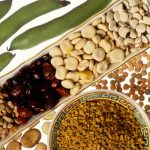 Are sugar-binding proteins that are highly specific for their sugar moieties. They play a role in biological recognition phenomena involving cells and proteins.
Are sugar-binding proteins that are highly specific for their sugar moieties. They play a role in biological recognition phenomena involving cells and proteins.
Carbohydrate-binding proteins.
Proteins from legumes and other sources which bind to the carbohydrates found at cell surfaces. They therefore cause red blood cells to agglutinate in vitro, hence the old names haemagglutinins and phytoagglutinins.
A class of proteins that have the capability to rapidly (and reversibly) combine with specific sugar molecules (e.g., those sugar molecules or glycoproteins on the surface of adjacent cells, within an organism). Lectins are a common component of the surface (membranes) of plant and animal cells; and are so specific (regarding sugar molecules that they will or won’t combine with/(attach to) that they discriminate between different monosaccharides and different oligosaccharides (i.e., on the surfaces of adjacent cells within an organism). This capability to reversibly combine with sugar (i.e., carbohydrate) molecules (on the surface of adjacent cells) is ufilized by:
- bacteria and other microorganisms, to adhere to (sugar molecules on surface of) host cells, as the first step in the process of infecting those host cells
- white blood cells (e.g., lymphocytes), to adhere to the walls of blood vessels (endothelium), as the first step to leaving the bloodstream to go fight infection (pathogens, trauma) in tissue adjacent to that blood vessel. The lectin (glycoprotein) that adheres to the (endothelial sugar molecule on) blood vessel wall is called L-selectin, or the homing receptor. The two sugar molecules (glycoproteins) on blood vessel wall (endothelium) are called P-selectin and E-selectin (also known as ELAM-1)
- cancerous tumor cells, to adhere to the walls of blood vessels (endothelium) as part of the tumor-proliferation process known as metastasis (i.e., new tumors are “seeded” throughout the body via this process).
